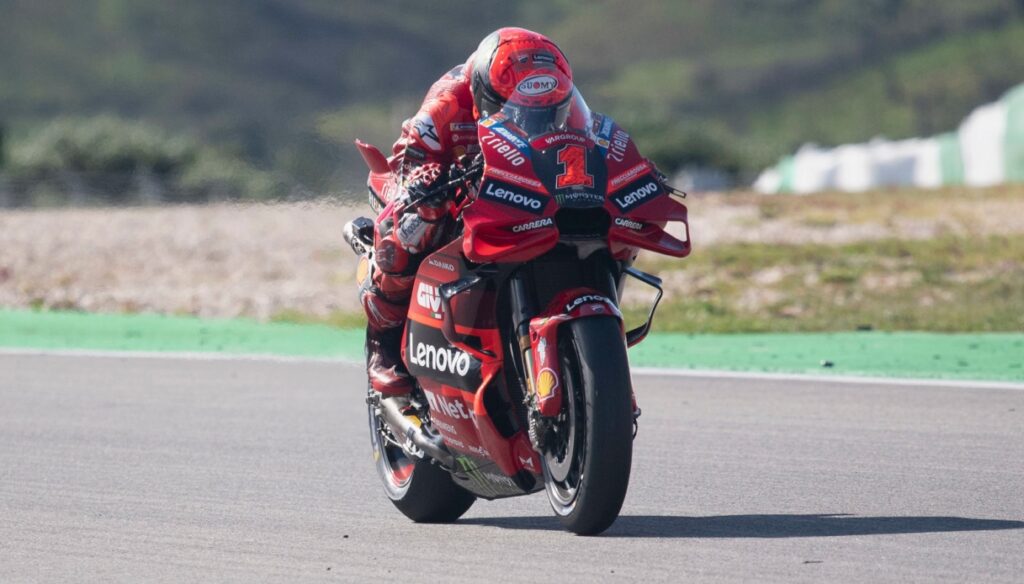
Ducati’s High-Stakes Engine Dilemma: A Look Ahead to MotoGP 2024
As the world gears up for the 2024 MotoGP season, Ducati faces a pivotal moment that could shape its performance for years to come. The Italian motorcycle manufacturer’s factory riders, Pecco Bagnaia and Marc Marquez, are caught in a whirlwind of decisions as they test two competing engine specifications: the new ‘GP25’ and the older ‘GP24.’ With the clock ticking down and an engine freeze set to take effect in 2026, their choice could have remarkable implications not just for their immediate success, but also for the future of the team. Let’s break down what this means for Ducati, its riders, and what it could mean for fans of the sport.
The Riders: Pecco Bagnaia and Marc Marquez
First off, let’s talk about the riders. Pecco Bagnaia, the reigning World Champion, is entering this season with high expectations. He has already shown his skills on the track, winning the title in 2022 and finishing strong in 2023. Bagnaia’s talent is unquestionable; his understanding of the bike and the races gives him an edge. On the other hand, we have Marc Marquez. Known for his fierce competitive spirit and remarkable achievements, including multiple world titles, Marquez has had a challenging few seasons due to injuries. However, he’s hungry to return to his former glory and contribute to Ducati’s development.
Both riders have different styles and preferences, and their opinions on the two engines could not be more critical. In their recent tests at Sepang—a famous circuit in Malaysia—they emphasized the need for a unified approach in choosing the best engine. The collaboration between two incredibly talented riders like Bagnaia and Marquez could lead to remarkable innovations for Ducati. But it also highlights the pressure both riders face in making the right choice.
The Engines: GP25 vs. GP24
So, what exactly are these new engine models, and why does it matter? The GP25 is the latest model introduced by Ducati, boasting advanced technology and features aimed at enhancing performance. Its power delivery and acceleration are strong selling points, promising a smoother ride. In contrast, the GP24 isn’t outdated just yet—the engine has proven its mettle with outstanding braking performance and has become a reliable choice for many racers.
Ducati is torn between the promise of innovation and the tried-and-true capabilities of the GP24. It’s like comparing a brand-new smartphone loaded with features to an older model that performs exceptionally well.
During the tests, both Bagnaia and Marquez gave feedback that showed they appreciated the strengths of both engines. Bagnaia spoke glowingly about how the GP25 felt refined and powerful, while Marquez noted the GP24’s exceptional braking, which can be a game-changer in races where every second counts. This overlap in praise does present an interesting conundrum: while the GP25 excites both riders with its potential, the GP24 provides reliability—a critical factor during a grueling season.
The Engine Freeze and What It Means
One of the most daunting aspects of this decision is the impending engine freeze slated for 2026. Once Ducati commits to one of these engines, they will be stuck with that choice for two full years. This means that their performance, strategy, and even how they develop their bikes could be heavily influenced by what they choose now.
Imagine being a high school student who has to choose classes for the next two years. You want to do well in subjects you enjoy, but you also need to think about how that choice prepares you for future opportunities—college, careers, whatever comes next. This is precisely the kind of dilemma Ducati faces.
Choosing the right engine could set them up for success or leave them struggling to catch up while others improve and innovate. This is why both riders are completely focused on testing and evaluating which engine will give them the competitive edge they need against other teams that are always refining their technology.
The Pressure of the Decision
As both riders continue evaluating the two engines, there’s no doubt that pressure is mounting. Fans expect nothing less than a championship-winning performance from Ducati, and with both heavyweight riders on the team, this is a critical moment in the sport.
Bagnaia and Marquez are well aware of this pressure. They know that the stakes are incredibly high, and a wrong decision could have repercussions that stretch into their future races. Marquez has been vocal about the need for “clarity” in their direction. It’s essential to identify which engine aligns better with both their racing styles and the team’s long-term strategy.
At the same time, teams like Yamaha and Honda are constantly refining their engines and technologies. They won’t be sitting idly by, waiting for Ducati to make its decision. The competition is fierce, and every moment counts on the racetrack. The MotoGP world is unforgiving, and the teams chasing the podium spots are fully aware that this isn’t just about who is fastest, but about who has the most reliable technology to support their ambitions.
Conclusion: A Road Ahead Full of Possibilities
In conclusion, Ducati stands at a crossroads that will profoundly impact its path in MotoGP. The assessments from riders Pecco Bagnaia and Marc Marquez underscore how crucial it is for them to make the right choice as they prepare for the 2024 season. With just a few testing days left, every minute counts, and the assessments will not just affect the next couple of races; they could influence the entire season.
This exhilarating journey reminds us that racing isn’t just about speed; it’s about strategy, teamwork, and making choices that resonate beyond the immediate moment. As fans of the sport, we are lucky to witness this high-stakes drama unfold on our screens.
What do you think Ducati should do? Should they take a leap of faith with the new GP25, or stick with the tried-and-true GP24? I’d love to hear your thoughts—leave a comment below and let’s discuss!




